The Shipping Label Market is estimated to be valued at USD 2.3 billion in 2025 and is projected to reach USD 3.5 billion by 2035, registering a compound annual growth rate (CAGR) of 4.2% over the forecast period.
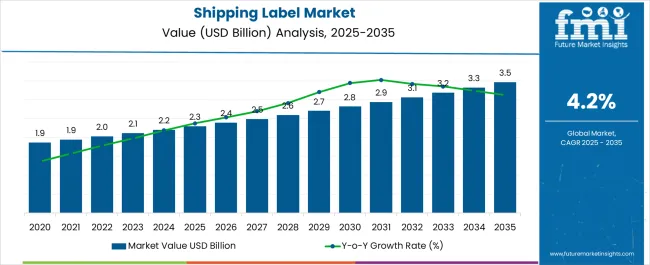
| Metric | Value |
|---|---|
| Shipping Label Market Estimated Value in (2025 E) | USD 2.3 billion |
| Shipping Label Market Forecast Value in (2035 F) | USD 3.5 billion |
| Forecast CAGR (2025 to 2035) | 4.2% |
The Shipping Label market is experiencing robust growth, driven by the rapid expansion of e-commerce, logistics, and global supply chain operations. Increasing demand for efficient and accurate product identification and tracking is fueling the adoption of advanced labeling solutions across industries. Digital transformation in logistics and the rising need for automation are promoting the use of high-quality labels that support barcode scanning, real-time tracking, and error-free shipping operations.
Innovations in printing technologies, materials, and adhesive formulations are enhancing label durability and adaptability to various environmental conditions, including temperature fluctuations and moisture exposure. Regulatory requirements related to product traceability, safety labeling, and compliance standards are further boosting adoption.
Manufacturers and logistics providers are prioritizing labels that improve operational efficiency while reducing errors, returns, and material wastage As the global e-commerce sector continues to expand and supply chains become increasingly complex, the Shipping Label market is expected to witness sustained growth, with technology-enabled, customizable, and durable label solutions driving widespread adoption across sectors.
The shipping label market is segmented by product type, technology type, material type, material type - plastics, and geographic regions. By product type, shipping label market is divided into Non-Adhesive Based, Glue Applied, In-Mold Label, Sleeve Label, Adhesive Based Permanent, and Removable. In terms of technology type, shipping label market is classified into Digital Printed Labels, Thermal Printed Labels, Lithographic Printed Labels, and Flexographic Printed Labels. Based on material type, shipping label market is segmented into Specialty Papers, Foil, and Plastics. By material type - plastics, shipping label market is segmented into Polypropylene (PP), Polyethylene (PE), Polystyrene (PS), Polyvinyl Chloride (PVC), Polycarbonate (PC), Polymethyl Methacrylate (PPMA), and Others (PET). Regionally, the shipping label industry is classified into North America, Latin America, Western Europe, Eastern Europe, Balkan & Baltic Countries, Russia & Belarus, Central Asia, East Asia, South Asia & Pacific, and the Middle East & Africa.
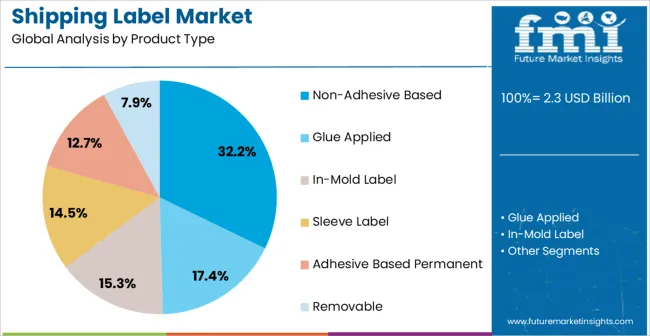
The non-adhesive based product type segment is projected to hold 32.2% of the market revenue in 2025, establishing it as the leading product category. Growth is being driven by its flexibility in use for temporary labeling, reusable applications, and cost-effective shipping operations. Non-adhesive labels can be easily removed or repositioned without leaving residue, making them ideal for logistics, warehousing, and inventory management purposes.
Their compatibility with automated labeling systems and digital printers further enhances efficiency. Businesses are leveraging these labels to reduce waste and maintain compliance with operational standards while supporting eco-friendly practices.
The segment’s market leadership is reinforced by the increasing demand for temporary and adaptable labeling solutions in high-volume shipping environments As organizations focus on operational optimization and cost reduction, non-adhesive based labels are expected to maintain their top position, supported by innovations in material strength, print quality, and handling convenience that improve overall supply chain performance.
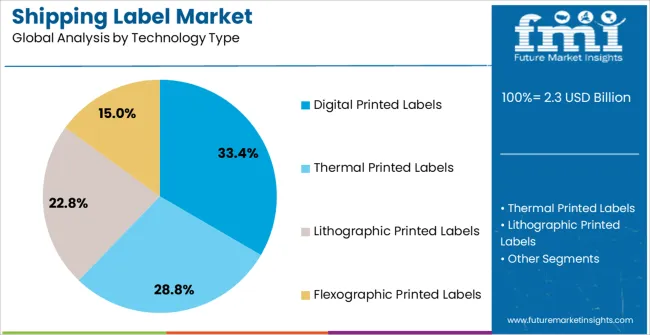
The digital printed labels technology segment is anticipated to account for 33.4% of the market revenue in 2025, making it the leading technology category. Growth in this segment is being driven by the need for high-resolution, customizable, and accurate labels that support dynamic printing requirements in logistics and e-commerce operations. Digital printing enables rapid production of variable data labels, including barcodes, QR codes, and tracking information, which improves traceability and reduces errors.
This technology eliminates the need for plates or tooling, allowing for faster turnaround times and lower setup costs. Businesses are increasingly adopting digital printed labels to support on-demand printing, reduce inventory of pre-printed labels, and improve operational flexibility.
The ability to produce high-quality, scalable, and customizable labels enhances efficiency in packaging, shipping, and warehousing workflows As global supply chains expand and customer expectations for accurate and timely deliveries increase, digital printed labels are expected to maintain their leading share, driven by precision, adaptability, and integration with automated labeling systems.
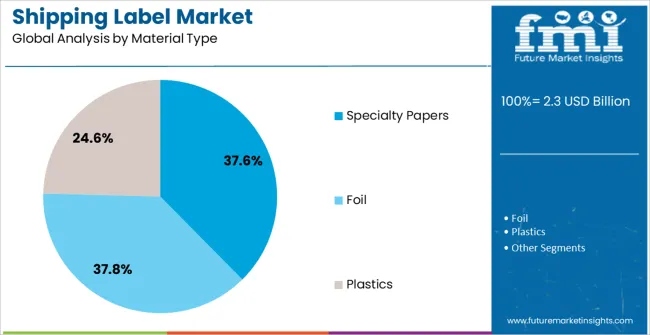
The specialty papers material segment is projected to hold 37.6% of the market revenue in 2025, establishing it as the leading material category. Growth in this segment is being driven by its superior print quality, durability, and resistance to smudging, tearing, or environmental factors such as moisture and temperature variations.
Specialty papers allow for high-resolution printing of barcodes, tracking information, and branding elements, making them essential for logistics, retail, and e-commerce labeling applications. The segment’s leadership is further reinforced by the increasing demand for recyclable and eco-friendly materials, as sustainability becomes a priority for businesses and regulatory authorities.
Specialty papers provide compatibility with a wide range of printing technologies, including digital, thermal, and inkjet printing, which enhances operational flexibility As supply chains become more complex and consumer expectations for accurate, durable, and environmentally responsible labeling increase, specialty papers are expected to maintain their dominance, supported by continuous material innovations that improve functionality, reliability, and overall performance.
Analysts attribute the market growth to the versatility and efficiency of shipping labels.The simplicity and growing customer awareness of shipping labels make them a popular option. There has been an increase in the need for shipping labels, particularly for pharmaceutical supplies. The market has benefited from the e-commerce sector as well since items and packaging now utilize shipping labels.
The main goals of manufacturers are to provide shipping labels that are robust and resistant to water, UV light, and temperature changes. The demand for goods like apparel and style has grown because of the rise in per capita disposable income. The usage of packaged food and beverages has expanded due to busy lives, which has boosted sales of shipping labels. These labels may be customized to meet the demands and trends of consumers, and they can be innovative or basic, depending on the product.
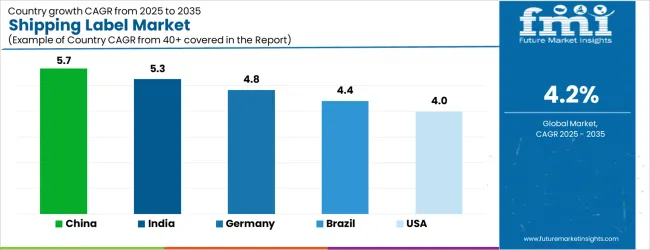
| Country | CAGR |
|---|---|
| China | 5.7% |
| India | 5.3% |
| Germany | 4.8% |
| Brazil | 4.4% |
| USA | 4.0% |
| UK | 3.6% |
| Japan | 3.2% |
The Shipping Label Market is expected to register a CAGR of 4.2% during the forecast period, exhibiting varied country level momentum. China leads with the highest CAGR of 5.7%, followed by India at 5.3%. Developed markets such as Germany, France, and the UK continue to expand steadily, while the USA is likely to grow at consistent rates. Japan posts the lowest CAGR at 3.2%, yet still underscores a broadly positive trajectory for the global Shipping Label Market. In 2024, Germany held a dominant revenue in the Western Europe market and is expected to grow with a CAGR of 4.8%. The USA Shipping Label Market is estimated to be valued at USD 797.5 million in 2025 and is anticipated to reach a valuation of USD 797.5 million by 2035. Sales are projected to rise at a CAGR of 0.0% over the forecast period between 2025 and 2035. While Japan and South Korea markets are estimated to be valued at USD 119.5 million and USD 66.1 million respectively in 2025.
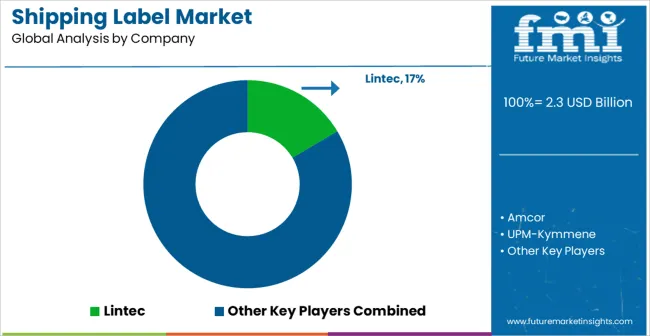
| Item | Value |
|---|---|
| Quantitative Units | USD 2.3 Billion |
| Product Type | Non-Adhesive Based, Glue Applied, In-Mold Label, Sleeve Label, Adhesive Based Permanent, and Removable |
| Technology Type | Digital Printed Labels, Thermal Printed Labels, Lithographic Printed Labels, and Flexographic Printed Labels |
| Material Type | Specialty Papers, Foil, and Plastics |
| Material Type - Plastics | Polypropylene (PP), Polyethylene (PE), Polystyrene (PS), Polyvinyl Chloride (PVC), Polycarbonate (PC), Polymethyl Methacrylate (PPMA), and Others (PET) |
| Regions Covered | North America, Europe, Asia-Pacific, Latin America, Middle East & Africa |
| Country Covered | United States, Canada, Germany, France, United Kingdom, China, Japan, India, Brazil, South Africa |
| Key Companies Profiled | Lintec, Amcor, UPM-Kymmene, 3M, CCL Industries, WS Packaging Group, Herma, Fuji Seal International, PMC Label, and Robos GmbH |
The global shipping label market is estimated to be valued at USD 2.3 billion in 2025.
The market size for the shipping label market is projected to reach USD 3.5 billion by 2035.
The shipping label market is expected to grow at a 4.2% CAGR between 2025 and 2035.
The key product types in shipping label market are non-adhesive based, glue applied, in-mold label, sleeve label, adhesive based permanent and removable.
In terms of technology type, digital printed labels segment to command 33.4% share in the shipping label market in 2025.






Our Research Products

The "Full Research Suite" delivers actionable market intel, deep dives on markets or technologies, so clients act faster, cut risk, and unlock growth.

The Leaderboard benchmarks and ranks top vendors, classifying them as Established Leaders, Leading Challengers, or Disruptors & Challengers.

Locates where complements amplify value and substitutes erode it, forecasting net impact by horizon

We deliver granular, decision-grade intel: market sizing, 5-year forecasts, pricing, adoption, usage, revenue, and operational KPIs—plus competitor tracking, regulation, and value chains—across 60 countries broadly.

Spot the shifts before they hit your P&L. We track inflection points, adoption curves, pricing moves, and ecosystem plays to show where demand is heading, why it is changing, and what to do next across high-growth markets and disruptive tech

Real-time reads of user behavior. We track shifting priorities, perceptions of today’s and next-gen services, and provider experience, then pace how fast tech moves from trial to adoption, blending buyer, consumer, and channel inputs with social signals (#WhySwitch, #UX).

Partner with our analyst team to build a custom report designed around your business priorities. From analysing market trends to assessing competitors or crafting bespoke datasets, we tailor insights to your needs.
Supplier Intelligence
Discovery & Profiling
Capacity & Footprint
Performance & Risk
Compliance & Governance
Commercial Readiness
Who Supplies Whom
Scorecards & Shortlists
Playbooks & Docs
Category Intelligence
Definition & Scope
Demand & Use Cases
Cost Drivers
Market Structure
Supply Chain Map
Trade & Policy
Operating Norms
Deliverables
Buyer Intelligence
Account Basics
Spend & Scope
Procurement Model
Vendor Requirements
Terms & Policies
Entry Strategy
Pain Points & Triggers
Outputs
Pricing Analysis
Benchmarks
Trends
Should-Cost
Indexation
Landed Cost
Commercial Terms
Deliverables
Brand Analysis
Positioning & Value Prop
Share & Presence
Customer Evidence
Go-to-Market
Digital & Reputation
Compliance & Trust
KPIs & Gaps
Outputs
Full Research Suite comprises of:
Market outlook & trends analysis
Interviews & case studies
Strategic recommendations
Vendor profiles & capabilities analysis
5-year forecasts
8 regions and 60+ country-level data splits
Market segment data splits
12 months of continuous data updates
DELIVERED AS:
PDF EXCEL ONLINE
Labels Market Forecast and Outlook 2025 to 2035
Label Applicators Market Size and Share Forecast Outlook 2025 to 2035
Shipping Supply Market Size and Share Forecast Outlook 2025 to 2035
Labeling and Coding Equipment Market Size and Share Forecast Outlook 2025 to 2035
Labels, Tapes And Films Market Size and Share Forecast Outlook 2025 to 2035
Shipping Tapes Market Size and Share Forecast Outlook 2025 to 2035
Labeling Equipment Market Analysis - Size, Share, and Forecast Outlook 2025 to 2035
Shipping Mailers Market Size and Share Forecast Outlook 2025 to 2035
Label Printers Market Size, Growth, and Forecast 2025 to 2035
Shipping Container Market Size, Share & Forecast 2025 to 2035
Labelling Machine Market Growth & Industry Trends through 2035
Competitive Overview of Labels Companies
Key Players & Market Share in the Label Applicators Industry
Competitive Breakdown of Labeling Equipment Providers
Leading Providers & Market Share in Shipping Tapes
Competitive Breakdown of Shipping Mailers Manufacturers
Labeling Software Market Growth - Trends & Forecast through 2034
Label Printing Software Market – Smart Labeling & Automation
GHS Label Market Size and Share Forecast Outlook 2025 to 2035
USA Labels Market Size and Share Forecast Outlook 2025 to 2035

Thank you!
You will receive an email from our Business Development Manager. Please be sure to check your SPAM/JUNK folder too.
Chat With
MaRIA